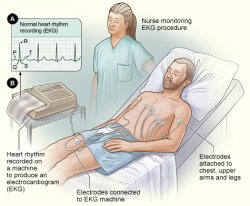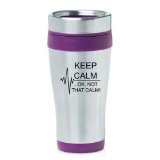Travel ekg
Doctors use a test called an EKG (electrocardiogram) to help diagnose heart block. This test detects and records the heart's electrical activity. An EKG records the strength and timing of electrical signals as they pass through the heart.
The data are recorded on a graph so your doctor can study your heart's electrical activity. Different parts of the graph show each step of an electrical signal's journey through the heart.
EKG

The image shows the standard setup for an EKG. In figure A, a normal heart rhythm recording shows the electrical pattern of a regular heartbeat. In figure B, a patient lies in a bed with EKG electrodes attached to his chest, upper arms, and legs. A nurse monitors the painless procedure.
Each electrical signal begins in a group of cells called the sinus node or sinoatrial (SA) node. The SA node is located in the right atrium (AY-tree-um), which is the upper right chamber of the heart. (Your heart has two upper chambers and two lower chambers.)
In a healthy adult heart at rest, the SA node sends an electrical signal to begin a new heartbeat 60 to 100 times a minute.
From the SA node, the signal travels through the right and left atria. This causes the atria to contract, which helps move blood into the heart's lower chambers, the ventricles (VEN-trih-kuls). The electrical signal moving through the atria is recorded as the P wave on the EKG.
The electrical signal passes between the atria and ventricles through a group of cells called the atrioventricular (AV) node. The signal slows down as it passes through the AV node. This slowing allows the ventricles enough time to finish filling with blood. On the EKG, this part of the process is the flat line between the end of the P wave and the beginning of the Q wave.
The electrical signal then leaves the AV node and travels along a pathway called the bundle of His. From there, the signal travels into the right and left bundle branches. The signal spreads quickly across your heart's ventricles, causing them to contract and pump blood to your lungs and the rest of your body. This process is recorded as the QRS waves on the EKG.
The ventricles then recover their normal electrical state (shown as the T wave on the EKG). The muscle stops contracting to allow the heart to refill with blood. This entire process continues over and over with each new heartbeat.
The animation below shows how your heart's electrical system works and how an EKG records your heart's electrical activity. Click the "start" button to play the animation. Written and spoken explanations are provided with each frame. Use the buttons in the lower right corner to pause, restart, or replay the animation, or use the scroll bar below the buttons to move through the frames.

|
Ekg-Zipkord 59unta ZipKord Universal Travel Adapter Plug Converter Black Personal Computer (Ekg/Zipkord)
|
|
Elite Kitchen Gear Self Stirring Camera Lens Travel & Novelty Coffee Cup Mug / Tumbler With Lid - Replica of Canon EF 24-105mm Lens. Great Fun and a Perfect Gift For Your Camera Enthusiast, Superhero, Sports Fan or Anyone. 11oz Stainless Steel Thermos Inside. 100% SATISFACTION GUARANTEE! Kitchen (Elite Kitchen Gear™)
|

|
Nurse/Medical EKG Heart Travel Mug Kitchen (Scrub Stuff)
|

|
ZipKord 650UP Mobile Device Universal Power Pack with Retractable Micro Cable and iPhone Tip - Retail Packaging - Black Wireless (ZipKord)
|

|
16oz Insulated Stainless Steel Travel Mug Nurse Paramedic Medical EKG Keep Calm Ok Not That Calm (Purple) Kitchen (MIP)
|





